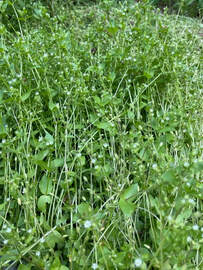
Disclaimer: I am an amateur at woodscraft and herblore. Nothing below should be taken as advice or recommendations. I am merely experimenting. Please do your own research before consuming or using any plant for medicinal purposes.
The plague, and working from home, has given me a unique opportunity to watch the land around me change from year to year. Several years ago, the invasive Japanese Stiltgrass was the dominant ground cover here, especially near my garden. Last year, it was Cleavers (which I will talk more about soon). This year, it is Chickweed. There is a thick carpet of it everywhere on the top of this hill and I do not ever recall seeing it in this location before.
Research tells me that this will die off as soon as summer rolls in, but I pulled most of it from around the garden now, and will be pulling more for some experiments over the next few days.
The name comes from the fact that apparently chickens love to eat this plant, and the Old English form of the name is ‘cicene mete’ (chicken meat). The plant is found in association with archaeological digs from the Saxon period in England (McKerracher, Anglo-Saxon Crops and Weeds, 2019). I will note that the internet states that it initially flourished in Eurasia and naturalized elsewhere over time, but I am not going that deep into the ultimate origins for these things. There is evidence of the plant from the Coppergate site at York. (Leechcraft, 107) I am looking mainly to see if they would be period for my Forester persona (14th Century England), and clearly it is.
The plague, and working from home, has given me a unique opportunity to watch the land around me change from year to year. Several years ago, the invasive Japanese Stiltgrass was the dominant ground cover here, especially near my garden. Last year, it was Cleavers (which I will talk more about soon). This year, it is Chickweed. There is a thick carpet of it everywhere on the top of this hill and I do not ever recall seeing it in this location before.
Research tells me that this will die off as soon as summer rolls in, but I pulled most of it from around the garden now, and will be pulling more for some experiments over the next few days.
The name comes from the fact that apparently chickens love to eat this plant, and the Old English form of the name is ‘cicene mete’ (chicken meat). The plant is found in association with archaeological digs from the Saxon period in England (McKerracher, Anglo-Saxon Crops and Weeds, 2019). I will note that the internet states that it initially flourished in Eurasia and naturalized elsewhere over time, but I am not going that deep into the ultimate origins for these things. There is evidence of the plant from the Coppergate site at York. (Leechcraft, 107) I am looking mainly to see if they would be period for my Forester persona (14th Century England), and clearly it is.
As I mentioned in my last post, I am very diligent about safety with plants that I am only working with for the first time. Several sources recommended that you can identify by the flowers (five petals split so deeply that it looks like 10), a broken stem does NOT have milky sap and looking for a line of fine hairs running up the stem on one side (and it shifts position between sets of leaves). This plant matched numerous photos in books and online and all of the criteria above.
So Chickweed is edible (not recommended for pregnant women) both raw or cooked and supposedly is rather nutritious (and high in iron). Tonight I incorporated it into my salad, and also plan to eventually sautee a bit in butter to sample.
Another relevant thing that I learned this week is that chiggers (Trombicula alfreddugesi), the menace of the region where I am in the US, apparently have a close relative that lives in England that has the common name Harvest Mite (Neotrombicula autumnalis). Chigggers eat me alive in the late spring/summer, and I am starting to see the wisdom of hosen and braies for my forestry project. Yes, it is May 17 and I have my first three bites already.
These bites will be a weeks-long-pain but, they also give me the opportunity to try out a medical application of Chickweed! Supposedly it can be chewed a few times and placed on an itchy bite to relieve the itch. This would be exceptionally practical in the field if the pests managed to skirt the well-covering clothing of the 14th century. Additionally, a poultice can be made with oil and I might attempt a salve later this week if I can track down my beeswax.
So, the Chickweed smells and tastes like fresh mown grass. It is not unpleasant, but I would not want to eat mouthfuls by itself. A bit in a salad is pleasant and adds a crunch like sprouts do. I rough chopped some and ground with a mortar and pestle and it produces a very stringy mass and a rich green liquid. In the future, I would more finely chop this up (or use a food processor but I am pretty sure that is not period, lol). I pressed some onto the first bite and it was very cooling and by the time it fell off a minute or so later, the itch had subsided. Now to see how long the effect lasts. (ETA, it lasts about 40 minutes. I only get an hour of relief from Benedryl gel, so that is not bad!)
So Chickweed is edible (not recommended for pregnant women) both raw or cooked and supposedly is rather nutritious (and high in iron). Tonight I incorporated it into my salad, and also plan to eventually sautee a bit in butter to sample.
Another relevant thing that I learned this week is that chiggers (Trombicula alfreddugesi), the menace of the region where I am in the US, apparently have a close relative that lives in England that has the common name Harvest Mite (Neotrombicula autumnalis). Chigggers eat me alive in the late spring/summer, and I am starting to see the wisdom of hosen and braies for my forestry project. Yes, it is May 17 and I have my first three bites already.
These bites will be a weeks-long-pain but, they also give me the opportunity to try out a medical application of Chickweed! Supposedly it can be chewed a few times and placed on an itchy bite to relieve the itch. This would be exceptionally practical in the field if the pests managed to skirt the well-covering clothing of the 14th century. Additionally, a poultice can be made with oil and I might attempt a salve later this week if I can track down my beeswax.
So, the Chickweed smells and tastes like fresh mown grass. It is not unpleasant, but I would not want to eat mouthfuls by itself. A bit in a salad is pleasant and adds a crunch like sprouts do. I rough chopped some and ground with a mortar and pestle and it produces a very stringy mass and a rich green liquid. In the future, I would more finely chop this up (or use a food processor but I am pretty sure that is not period, lol). I pressed some onto the first bite and it was very cooling and by the time it fell off a minute or so later, the itch had subsided. Now to see how long the effect lasts. (ETA, it lasts about 40 minutes. I only get an hour of relief from Benedryl gel, so that is not bad!)
I added a bit of vinegar (apple cider because it was the closest thing at that moment) and ground it a bit longer and added that to the second bite. It held on a bit longer than the first application and had a similar, and possibly slightly better, effect. Finally, I chewed a bit of the plant and applied that to the third bite. It held the best and had a similar effect to the first application.
I also heated some water, soaked the plants for about 5 minutes and then ground them up with the mortar and pestle. This concoction was much more sticky and very easily stayed on the bite for a good 5 minutes. Adding a bit of olive oil (my choices here for fats are butter, olive oil and canola oil and cats would be licking off the butter so I went with the olive) made it cling even more so. The initial result was that these also stopped the itching but the results did not seem to last nearly as long as the unheated version.
I have some more books on the way and am hoping to better learn if any of these plants are mentioned, along with their period uses, in historic sources. I read from a very tertiary source that this particular plant was also part of medieval gardens, but do not have enough knowledge in that field to know yet if that is true or not. An article from 2014 in The Telegraph mentions that the book The Medieval Garden (S. Landsberg) references chickweed being added to the cooking pot. I have a copy coming so look forward to seeing what all is included in that work.
Persona Summary:
- This plant was likely known to a 14th Century Forester in England
- The understood properties in period might have been something that person had come across
- Plausible food source, potentially used in pottages and the like
- Test the plant as a poultice on bites
- Completed - effective at relieving the itching for 30-40 minutes
- Add the greens to a pottage
- Add greens to a salad
- Completed - tastes like grass but adds nice texture
- Create a salve with chickweed to use on scrapes or bites
- Completed - Further information HERE
List of Resources can be found HERE
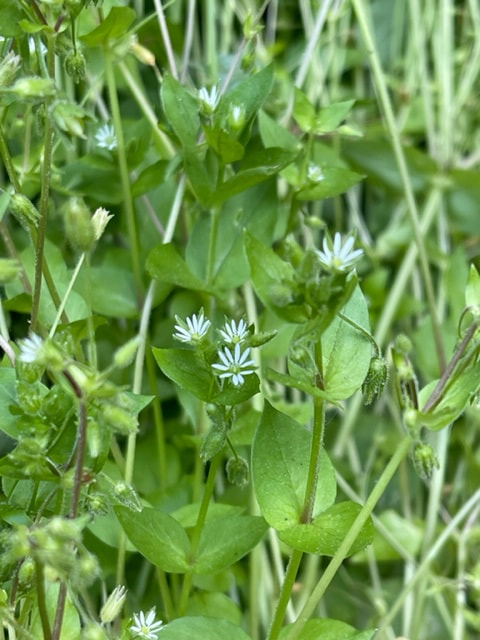
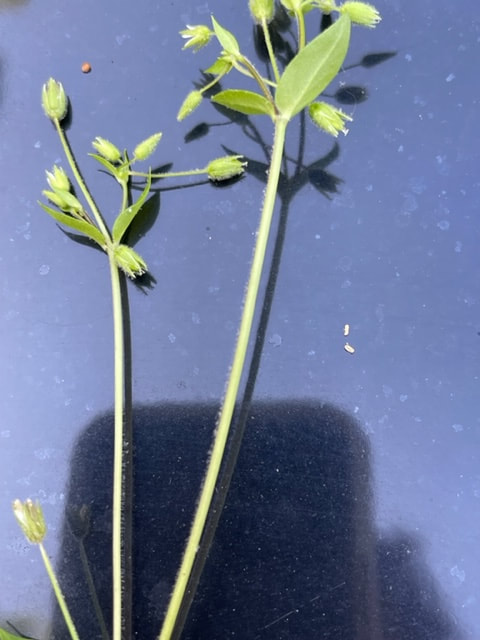
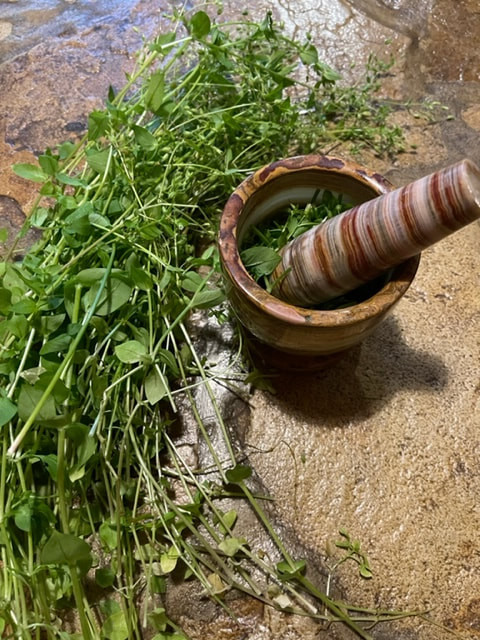
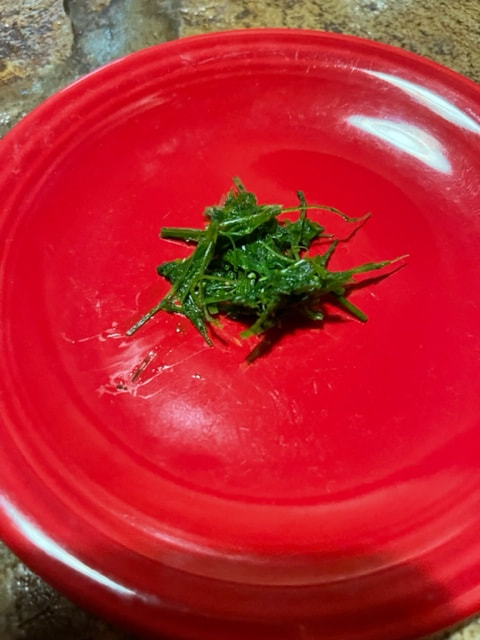
 RSS Feed
RSS Feed